Estate of Man (1967).
A short tribute to American artist Nick Hyde who I’ve been informed died last month. Hyde’s extraordinary paintings were featured here a few years ago after I found a copy of Visions (1977), an art book devoted to artists of the loosely-affiliated California Visionary school. Most of the paintings in the book are a type of fantastic art (not to be confused with fantasy art) that owes much to the hippy mysticism that later became codified as “New Age”, a vague term which covers a lot of territory. Several of the paintings were featured in the early issues of OMNI magazine but I don’t recall Nick Hyde’s art being among them. Hyde’s early paintings are darker and stranger than those of his Visions contemporaries, and they were ones I inevitably preferred to the rest, hence my earlier post highlighting his work. There isn’t much else I can say about him other than pointing to the official website and posting the following appraisal by Walter Hopps from Visions. All the paintings here are from Visions, and several of them (Abraxas in particular) look like they need to be seen at a much larger size.
Cryptyde (1967).
I am not trying to clean myself of impurities, but to venture into a very real situation. I consider myself a true visionary—it comes to me and I flow with it. My imagery is always a dance.” Nick Hyde, 1976
The powerful nature of Nick Hyde’s art stands in certain important ways vividly apart from that presented here by his visionary colleagues. Rather than scenes of cosmic calm, serene process, or peaceful resolution, Hyde pours forth effulgent compositions of both hallucinatory intensity and tumultuous activity. The myriad visual events and details brought forth in an all-at-once total vision in Hyde’s paintings give rise to a unique tension between what seems the most violent of struggles and the most delicate of dances. In maintaining qualities of such polarity Hyde reveals a mastery of a sinuous, insinuating line structure that both divulges and dissolves images.
Inside Out Breaking Free (1968).
In his extraordinary allegorical painting Estate of Man, human figures are disgorged from a Gothic tracery of lines that suggests the network of nerves of a livid inner eye. Closer inspection reveals the jaws of a hell-mouth that swallows these figures and assimilates them as functioning fibers in a self-conceiving infernal machine. At upper right, however, in a zone of apparent transcendence, Hyde paints a luminist landscape at the moment of sunrise. It is perhaps where one is to find redemption in the Eye of God: or is it merely the burning earth that bears man to offer him to hell?
BethAnn (1969).
Hyde’s painting Abraxas touches on a note of subtle, mordant humor: the mythoid monster and his serpent-headed mate entwined in an infernal lair is, at the same time, a gentleman with his lady, reclining at ease, casually smoking. and telephone in hand. A clock—on the fire-place mantle at the right of the composition—is without hands, and ornamented by two barely perceptible figures. They repeat in reverse the pose of the two polymorphic companions. Abraxas, a god of good and evil, exists in a world abandoned of time, of rhythmic mimesis, of smoldering mockery. —Walter Hopps
Urp (1970).
Abraxas (1971).
Elsewhere on { feuilleton }
• The fantastic art archive
Previously on { feuilleton }
• Visions and the art of Nick Hyde

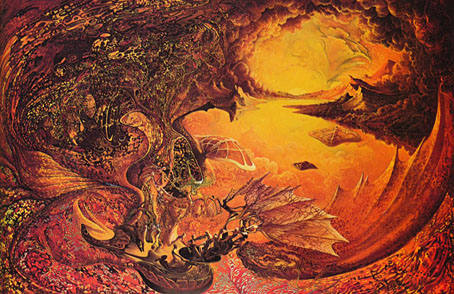
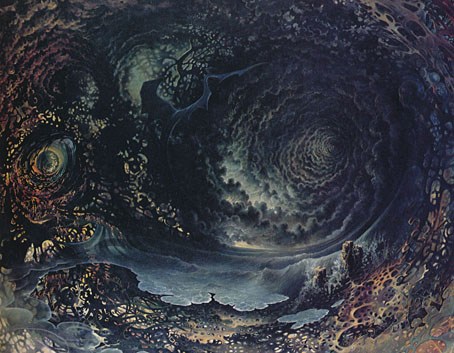
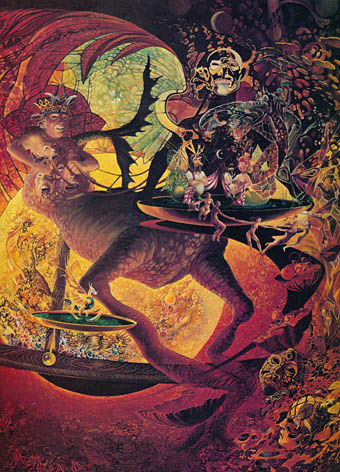
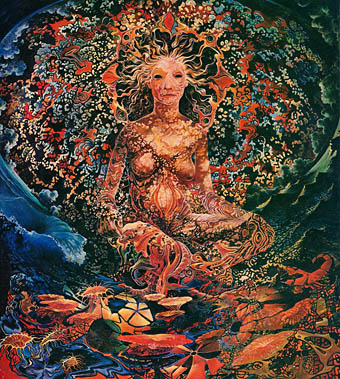
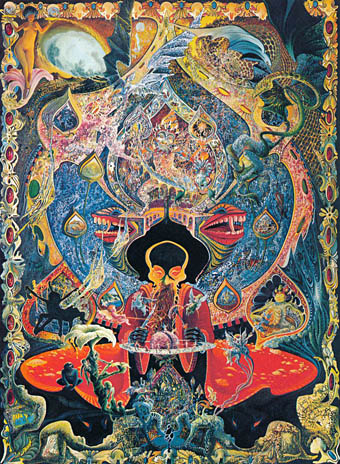
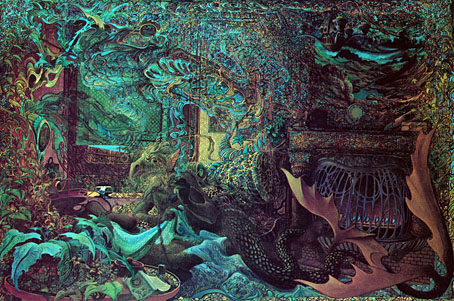
One of the many things I appreciate about your blog (it is, in fact, a marvellous museum of enthralling esoterica) is your archiving of marginalised artists. I occasionally scour the internet in search of the great lost Scots surrealist, but surrealism is something that we have tended to casually flirt with than remain committed to with any degree of earnestness. Scottish artists of the fantastic and grotesque, without lapsing into satire or whimsy or twee, are few and far between. Curse Britain’s cultural isolationism!
Thanks, Liam. One of my pet rants–which I’ve aired here a few times–concerns the way the imagination has often been treated as a suspect thing in Anglophone culture, especially Britain where accusations of “kitsch” or “bad taste” were swift to be deployed. Things have changed now, in part because pop culture and all manner of genre material have overwhelmed the media. But this doesn’t help populate the deserts of the past, of course, hence the need to keep searching for the neglected.
Hello. Thank you for such a lovely tribute to my late husband. Your words eloquently described the mood and attitude of Nick’s painting. His art talent stayed with him to the very end. I will be posting his facebook feed on the website with comments from his friends and fans + photos of his last show.
One thing the dates on the photos are off but I will correct them on the site. Cryptyde was his first painting – I will sort the order on his site soon.
Hi Beth. Thanks for the comment, and my sympathies to you. I try to be diligent about painting titles or dates but information isn’t always easy to source. The Visions book lists many of Nick Hyde’s paintings as “Untitled” so I was at least able to find the titles. I’m not on Facebook but you’re welcome to post a link here if you wish.
Please keep me informed as to a memorial for our pal Nick-
and fellow SFAI Alumni
Josie Grant,mfa
Visonary Artist